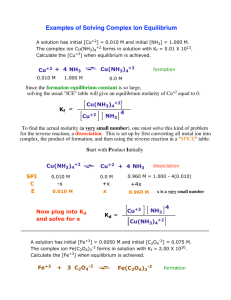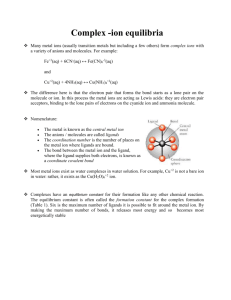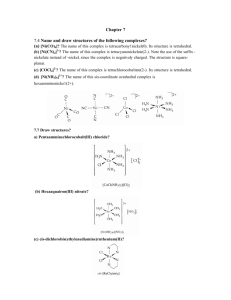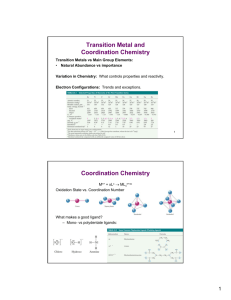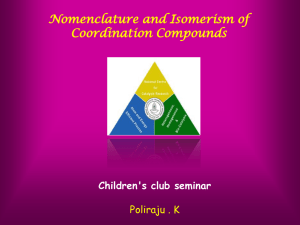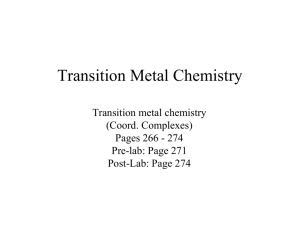Chapter 21
advertisement
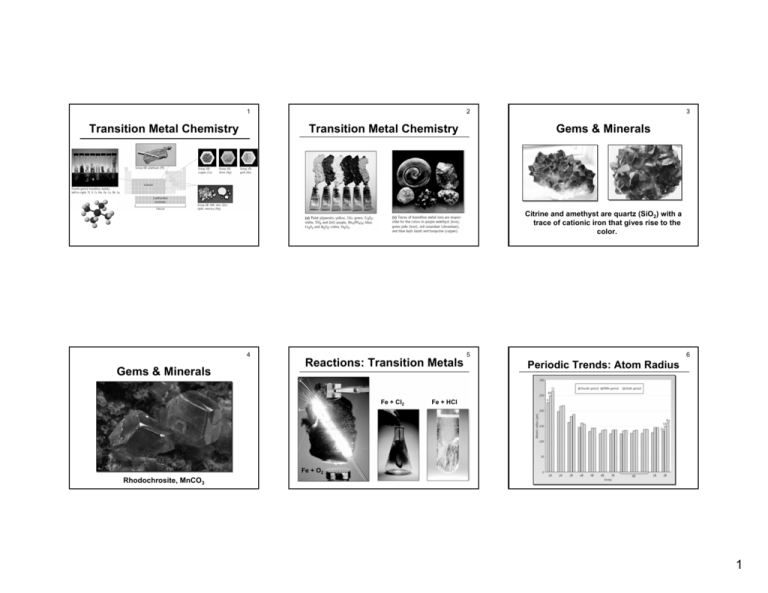
1 Transition Metal Chemistry 2 Transition Metal Chemistry 3 Gems & Minerals Citrine and amethyst are quartz (SiO2) with a trace of cationic iron that gives rise to the color. 4 Gems & Minerals Reactions: Transition Metals Fe + Cl2 5 6 Periodic Trends: Atom Radius Fe + HCl Fe + O2 Rhodochrosite, MnCO3 1 Periodic Trends: Density 7 Periodic Trends: Melting Point 8 9 Periodic Trends: Oxidation Numbers Most common 10 Metallurgy: Element Sources 11 Electron Configuration • As you know from first semester chemistry, the transition metals have a little different electron configuration. – So, lets go back. • If the principle quantum number (n) is 3 what are the possibilities of l (orbital shape)? – That is right l can be 0, 1, or 2 – Which means that the d orbital exists in the 3rd row of the periodic table, but it is not filled. – Why? 12 Energy Levels • What are the basic rules for filling the d and f orbitals? – Hund’s Rule – Pauli Exclusion Principle – When filling the d orbitals subtract the principle quantum number by one. – When filling the f orbitals subtract the principle quantum number by two. • These are really an over simplification of what is really going on. • The reason why the d orbitals are filled where they are is really do to the fact the energies of the d orbitals are higher in energy than that of the s orbital in the next row. 2 Examples of Electron Configuration 13 Degenerate Energy Levels • Give me the electron configuration of ¾V ¾[Ar] 4s2, 3d3 ¾Fe ¾[Ar] 4s2, 3d6 ¾Zn ¾[Ar] 4s2, 3d10 ¾Cr ¾[Ar] 4s1, 3d5 ¾Cu ¾[Ar] 4s1, 3d10 14 Same Family! Oxidation States & Ionization Energies 15 • The reason why there Cr and Cu populate the d orbital first is really not because Hund’s rule. • It is because the 4s and 3d energy levels are degenerate (have about the same energy). • This allows this strange population of the 3d. ¾W ¾[Xe] 6s2, 4f14, 5d4 The 4d and 5d 16 Lanthanide Contraction 17 18 Section 21.2 • One way to convince yourself of these trends is to look at the atomic radii of the transition metals. • But when we look the atomic radii of the 4d and 5d elements we find that two rows have about the same atomic radii in each family. • As you can see the 2nd and 3rd series are about the same size. So we will only worry about the 1st transition metal • This is due to the extra protons in the nucleus from the series! lanthanides causing a contraction in the atomic size. • Is a small section on descriptive chemistry of the 1st row transition metals. • It gives you a little information about the %’s found in the earth’s crust, common uses, etc. • MAKE SURE YOU READ THIS! – Remember the core electrons vs. valence electrons – Effective shielding. 3 19 Coordination Chemistry CH2 21 CH2 Pt – Complex ion = a transition metal ion with its attached ligands – Ligands = a neutral molecule or ion having a lone pair of electrons that can be used to form a bond to a metal ion; a Lewis base. – Counterions = anions or cations as needed to produce a compound with no net charge. - Cl Cl Cl Coordination Chemistry 22 Coordination Chemistry Pt(NH3)2Cl2 Heme Co(H2O)62+ 20 • These coordination complexes typically consist of a complex ion and counterions. • Coordination compounds – combination of two or more atoms, ions, or molecules where a bond is formed by sharing a pair of electrons originally associated with only one of the compounds. Two Parts to a Coordination Complex. 23 24 Vitamin B12 A naturally occurring cobalt-based compound “Cisplatin” - a cancer chemotherapy agent Cu(NH3)42+ Co atom 4 25 Nomenclature Common Bidentate Ligands 26 27 Inner coordination sphere Ligand: monodentate + Bipyridine (bipy) Acetylacetone (acac) Cl- Ligand: bidentate Co3+ + 2 Cl- + 2 neutral ethylenediamine molecules Ethylenediamine (en) Oxalate (ox) Cis-dichlorobis(ethylenediamine)cobalt(II) chloride 28 Acetylacetonat e Complexes Multidentate Ligands EDTA4- - ethylenediaminetetraacetate ion 29 Multidentate Ligands 30 Co2+ complex of EDTA4Commonly called the “acac” ligand. Forms complexes with all transition elements. Multidentate ligands are sometimes called CHELATING ligands 5 Naming Coordination Compounds 31 [Co(NH3)5Cl]Cl2 32 [Co(NH3)5Cl]Cl2 • 2. Ligands are named before the metal ion. • ammine, chlorine named before cobalt • 4. The prefixes mono-, di-, tri-, etc., are used to denote the number of simple ligands. • penta ammine 34 Naming Coordination Compounds (continued) 33 [Co(NH3)5Cl]Cl2 • 3. For ligand, an “o” is added to the root name of an anion (fluoro, bromo). For neutral ligands the name of the molecule is used, with exceptions. • ammine, chloro • 1. Cation is named before the anion. • “chloride” goes last Naming Coordination Compounds (continued) Naming Coordination Compounds (continued) 35 • 5. The oxidation state of the central metal ion is designated by a (Roman numeral). • cobalt (III) • 6. When more than one type of ligand is present, they are named alphabetically. • pentaamminechloro 36 [Co(NH3)5Cl]Cl2 • 7. If the complex ion has a negative charge, the suffix “ate” is added to the name of the metal. • pentaamminechlorocobalt (III) chloride 6 Nomenclature 37 Co(H2O)62+ Nomenclature Pt( Name These 38 • 39 [Co(NH3)5Cl]Cl – Pentaamminechlorocobalt(II) chloride Tris(ethylenediamine)nickel(II) • K3Fe(CN)6 – Potassium hexacyanoferrate(III) • [Fe(en)2(NO2)2]2SO4 – Bis(ethylenediamine)dinitroiron(III) sulfate Hexaaquacobalt(II) Pt(NH3)2Cl2 Cu(NH3)42+ Tetraamminecopper(II) What is the molecular formula of these? [Ni(NH2C2H4NH2)3]2+ IrCl(CO)(PPh3)2 diamminedichloroplatinum(II) • Triamminebromoplatinum(II) chloride Vaska’s compound – [Pt(NH3)3Br]Cl Carbonylchlorobis(triphenylphosphine)iridium(I) • Potassium hexafluorocobaltate(III) – K3[CoF6] 40 41 • Two forms of isomerism – Constitutional – Stereoisomerism Isomerism • Constitutional (Structural) – Same empirical formula but different atom-to-atom connections • Coordination Isomerism • Linkage Isomerism • Stereoisomerism – Same atom-to-atom connections but different arrangement in space. • Geometrical Isomerism • Optical Isomerism Coordination Isomerism • Composition of the complex ion varies. • Example: – [Cr(NH3)5SO4]Br and [Cr(NH3)5Br]SO4 Linkage Isomerism • Composition of the complex is the same, but the point of attachment of at least one of the ligands differs. Example: 42 Structural Isomerism Structures of Coordination Compounds – [Cr(NH3)5SO4]Br and [Cr(NH3)5Br]SO4 7 43 Snp.swf Coordination Isomerism Aldehydes & ketones H 2O H 2O OH2 Cl Cl Cl OH2 Cr green O CH3-CH2-CH H 2O H 2O Linkage Isomerism NH3 2+ H 3N NO2 sunlight Co H 3N NH3 NH3 O H3C C CH3 44 Optical Isomerism • The isomers have opposite effects on plane-polarized light. • What?! violet Peyrone’s chloride: Pt(NH3) 2Cl2 Magnus’s green salt: [Pt(NH3)4][PtCl4] Stereoisomerism • One form is commonly called geometric isomerism or cis-trans isomerism. Occurs often with square planar complexes. cis trans Note: there are VERY few tetrahedral complexes. Would not have geometric isomers. 45 • A.K.A. cis-trans isomerism • Occurs when atoms of groups of atoms can assume different positions around a rigid ring or bond. 2+ NH3 H 3N ONO Co H 3N NH3 NH3 Such a transformation could be used as an energy storage device. OH2 OH2 Cl3 OH2 OH2 Cr Geometrical Isomerism 46 47 Geometric Isomerism Cis and trans-dichlorobis(ethylenediamine)cobalt(II) chloride 48 Geometric Isomerism Fac isomer Mer isomer 8 Figure 21.12: Unpolarized light consists of waves vibrating in many different planes (indicated by the arrows). The polarizing filter blocks all waves except those vibrating in a given plane. 49 50 Figure 21.13: The rotation of the plane of polarized light by an optically active substance. The angle of rotation is called theta (θ). 51 Stereoisomerism • Enantiomers: stereoisomers that have a non-superimposable mirror image – Two molecules that are related as object and mirror image, and to convert into the other would require the breaking of bonds. • Diastereoisomers: stereoisomers that do not have a non-superimposable mirror image (cis-trans isomers) – Steroisomers that are not related as object and mirror image are called diasteromers. • Asymmetric: lacking in symmetry—will have a non-superimposable mirror image • Chiral: an asymmetric molecule 52 53 An Enantiomeric Pair Figure 21.16: Isomers I and II of Co(en)33+ are mirror images (the image of I is identical to II) that cannot be superimposed. That is, there is no way that I can be turned in space so that it is the same as II. 54 [Co(NH2C2H4NH2)3]2+ 9 Figure 21.17: (a) The trans isomer of Co(en)2Cl2+ and its mirror image are identical (superimposable). (b) The + cis isomer of Co(en)2Cl2 and its mirror image are not superimposable and are thus a pair of optical isomers. 55 56 Stereoisomerism N Cl Co 2+ NH3 NH3 OH2 NH3 2+ NH3 Co N Cl OH2 N 58 Bonding in Coordination Compounds • Model must explain – Basic bonding between M and ligand – Color and color changes – Magnetic behavior – Structure • Two models available – Molecular orbital – Electrostatic crystal field theory Stereoisomerism [Co(en)(NH3)2(H2O)Cl]2+ N 57 NH3 2+ These two isomers have Cl a plane of symmetry. Co N OH2 Not chiral. NH3 N These two are NH3 2+ NH3 asymmetric. Have Co non-superimposable N OH2 mirror images. Cl N These are non-superimposable mirror images [Co(en)(NH3)2(H2O)Cl]2+ 59 Bonding in Coordination Compounds 60 Bonding in Coordination Compounds • As ligands L approach the metal ion M+, – L/M+ orbital overlap occurs – L/M+ electron repulsion occurs • Crystal field theory focuses on the latter, while MO theory takes both into account – Combination of the two ---> ligand field theory 10 61 Octahedral Ligand Field 62 Crystal Field Theory 63 • Consider what happens as 6 ligands approach an Fe3+ ion [Ar] ↑ ↑ ↑ ↑ ↑ five 3d orbitals 4s All electrons have the same energy in the free ion Orbitals split into two groups as the ligands approach. energy • Look at the locations of the orbitals of the dz2 and dx2-y2. • Because Crystal Field Theory want to minimize electron repulsion, the d orbitals rearrange Tetrahedral & Square Planar Ligand Field t2g 64 Figure 21.26: (a) Tetrahedral and octahedral arrangements of ligands shown inscribed in cubes.(b) The orientations of the 3d orbitals relative to the tetrahedral set of point charges. 65 eg ↑ ↑ d(x2-y2) dz2 ↑ dxy ↑ dxz Value of ∆o depends on L: e.g., H2O > Cl- ∆ E = ∆o ↑ dyz Crystal Field Theory 66 •Tetrahedral ligand field •Note that ∆t = 4/9 ∆o and so ∆t is small •Therefore, tetrahedral complexes tend to blue end of spectrum energy e ↑ dxy ↑ dxz ↑ dyz ∆ E = ∆t t2 ↑ ↑ d(x2-y2) dz2 11 67 Figure 21.28: (a) The crystal field diagram for a square planar complex oriented in the xy plane with ligands along the x and y axes. (b) The crystal field diagram for a linear complex where the ligands lie along the z axis. Crystal Field Theory 68 • Why are complexes colored? Crystal Field Theory 69 • Why are complexes colored? – Note that color observed is transmitted light Fe3+ Absorption M + hν Æ M* 70 Co2+ Ni2+ Cu2+ Zn2+ Absorption 71 M + hν Æ M* • Absorption = the process in which a chemical species in a transparent medium selectively attenuates (decreases the intensity of) certain frequencies of electromagnetic radiation When a photon of radiation passes near an elementary particle, absorption is probable ONLY if the energy of the photon (hν) EXACTLY matches the energy difference between the ground state and one of the higher energy states of the particle • According to quantum theory, every elementary particle (atom, ion, molecule) has a unique set of energy states, the lowest of which is called the ground state If the energy EXACTLY matches, the energy of the photon is transferred to the atom, ion, or molecule, converting to a higher energy state •These energy states are discrete, quantized energy states This higher energy state is called the excited state (M*) • At room temp, most particles are in their ground state (M) If the incident radiation has too much or too little energy to satisfy one of the allowed energy transitions, it will be transmitted through the sample without absorption Crystal Field Theory 72 • Why are complexes colored? – Note that color observed is transmitted light 12 Crystal Field Theory 73 • Why are complexes colored? Spectrochemical Series • d orbital splitting (value of ∆o) is in the order I- < Cl- < F- < H2O < NH3 < en < phen < CN- < CO – Note that color observed is transmitted light – Color arises from electron transitions between d orbitals – Color often not very intense – d1, d4, d6, and d9 --> 1 band – d2, d3, d7, and d8 --> 3 bands Weak-field Ligands (small ∆) • Spectrochemical series Magnetic Properties/Fe2+ Paramagnetic eg t2g High spin Weak ligand field ∆E small strength and/or lower Mn+ charge ↑ dxy ↑ dxz ↑ dyz – Aquamarine and kyanite are examples – Prussian blue • Color centers Strong-field Ligands (large ∆) I- > Br- > Cl - > F- > OH- > H2O > NH3 > en > NO2- > CN- – Amethyst has Fe4+ – When amethyst is heated, it forms citrine as Fe4+ is reduced to Fe3+ 75 The magnitude of ∆ for a given ligand increases as the charge on the metal ion increases. 76 Diamagnetic d(x2-y2) ↑ eg ↑ dxy ↑ t2g ↑ dz2 ↑ dxz Low spin dz2 ∆E large ↑ energy ↑ d(x2-y2) ↑ energy Other Ways to Induce Color • Intervalent transfer bands (IT) As ∆ increases, the absorbed light tends to blue, and so the transmitted light tends to red. • Spectra can be complex 74 ↑ dyz Stronger ligand field strength and/or higher Mn+ charge 13
